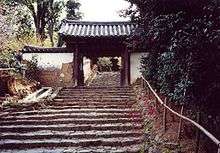Byakugō-ji
Byakugō-ji (白毫寺) is a Buddhist temple in Nara, Japan. A number of wooden statues of the Heian and Kamakura periods have been designated Important Cultural Properties and the temple's five-coloured camellias are a Prefectural Natural Monument.[1][2]
| Byakugō-ji 白毫寺 | |
|---|---|
 Temple road (sandō) | |
| Religion | |
| Affiliation | Shingon Risshū |
| Deity | Amida Nyorai (Amitābha) |
| Location | |
| Location | 392 Byakugōji-chō, Nara, Nara Prefecture |
| Country | Japan |
| Geographic coordinates | 34°40′15.65″N 135°51′4.35″E |
| Architecture | |
| Founder | Gonsō Gonzō (acc. legend) |
| Completed | 715 (acc. legend) |
Name
The byakugō or urna is the curl of white hair between the eyebrows that is one of the thirty-two physical characteristics of the Buddha.[3][4]
Buildings
The five by five bay Hondō, with tiled hipped roof, dates from the early Edo period (first half of the seventeenth century) and has been designated a Municipal Cultural Property.[5] A tahōtō was still standing in the Meiji period.[6]
Treasures
Byakugō-ji's seven Important Cultural Properties of Japan are, from the Heian period, an Amida Nyorai, and a bodhisattva traditionally identified as Monju Bosatsu and once enshrined in the temple's tahōtō, and from the Kamakura period, Enma-ō, attendants Shiroku (司録) and Shimyō (司命), Taizan-ō (太山王), Jizō Bosatsu, and Kōshō Bosatsu (興正菩薩) (Eison (叡尊).[1] The Taizan-ō was carved by Kōen (康円) in 1259 and has an inscription documenting repairs in 1498.[7][8]
See also
- For an explanation of terms concerning Japanese Buddhism, Japanese Buddhist art, and Japanese Buddhist temple architecture, see the Glossary of Japanese Buddhism.
References
| Wikimedia Commons has media related to Byakugoji. |
- 国指定文化財一覧 [List of National Cultural Properties] (in Japanese). Nara Prefecture. Archived from the original on 22 November 2015. Retrieved 29 November 2015.
- "奈良県指定文化財一覧" [List of Prefectural Cultural Properties of Nara Prefecture] (PDF) (in Japanese). Nara Prefecture. 1 April 2015. Archived from the original (PDF) on 17 November 2015. Retrieved 29 November 2015.
- Seckel, Dietrich (1985). "Buddhist Temple Names in Japan". Monumenta Nipponica. Sophia University. 40 (4): 378. JSTOR 2384822.
- "byakugou". Japanese Architecture and Art Net Users System. Retrieved 29 November 2015.
- 白毫寺本堂 [Byakugōji Hondō] (in Japanese). Nara City. Retrieved 29 November 2015.
- 白毫寺多宝塔 [Byakugōji Tahōtō] (in Japanese). Tokyo National Museum. Retrieved 29 November 2015.
- 木造太山王坐像〈康円作/〉 [Seated Wooden Statue of Taizan-ō (by Kōen)] (in Japanese). Agency for Cultural Affairs. Retrieved 29 November 2015.
- 太山王坐像(百毫寺) [Seated Statue of Taizan-ō (Byakugōji)] (in Japanese). Tobunken. Retrieved 29 November 2015.